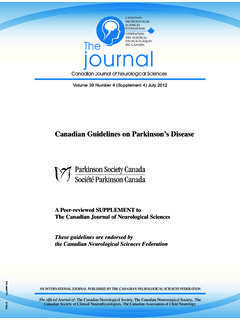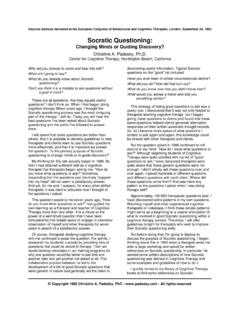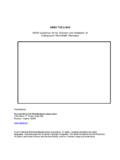Transcription of European Union herbal monograph on Ginkgo …
1 30 Churchill Place Canary Wharf London E14 5EU United Kingdom An agency of the European Union Telephone +44 (0)20 3660 6000 Facsimile +44 (0)20 3660 5555 Send a question via our website European Medicines Agency, 2015. Reproduction is authorised provided the source is acknowledged. 28 January 2015 EMA/HMPC/321097/ 2012 Committee on herbal Medicinal Products (HMPC) European Union herbal monograph on Ginkgo biloba L., folium Final Discussion in Working Party on European Union monographs and list (MLWP) May, Sep, Nov 2012 Jan, Mar, May, Jul, Sep, Nov 2013 Adoption by Committee on herbal Medicinal Products (HMPC) for release for consultation 28 January 2014 End of consultation (deadline for comments). 15 June 2014 Rediscussion in MLWP Sep, Nov 2014 Adoption by HMPC 28 January 2015 Keywords herbal medicinal products; HMPC; European Union herbal monographs ; well-established medicinal use; traditional use; Ginkgo biloba L.
2 , folium; Ginkgo folium; Ginkgo leaf BG (bulgarski): Гинко, лист CS ( e tina): jinanov list DA (dansk): Ginkgoblad DE (Deutsch): Ginkgobl tter EL (ellinik ): EN (English): Ginkgo leaf ES (espa ol): Ginkgo , hoja de ET (eesti keel): h lmikpuuleht FI (suomi): neidonhiuspuu, lehti FR (fran ais): Ginkgo (feuille de) HR (hrvatski): ginkov list HU (magyar): P fr nyfeny lev l IT (italiano): Ginkgo foglia LT (lietuvi kalba): Ginkmed i lapai LV (latvie u valoda): Ginka lapas MT (Malti): Werqa tal-Ginko NL (Nederlands): Ginkgo PL (polski): Li mi orz bu japo skiego PT (portugu s): Ginkgo , folha RO (rom n ): frunz de Ginkgo SK (sloven ina): List ginka SL (sloven ina): list ginka SV (svenska): Ginkgo , blad IS ( slenska): NO (norsk): Ginkgoblad European Union herbal monograph on Ginkgo biloba L., folium EMA/HMPC/321097/ 2012 Page 2/8 European Union herbal monograph on Ginkgo biloba L.
3 , folium 1. Name of the medicinal product To be specified for the individual finished product. 2. Qualitative and quantitative composition1,2 Well-established use Traditional use With regard to the marketing authorisation application of Article 10(a) of Directive 2001/83/EC as amended Ginkgo biloba L., folium ( Ginkgo leaf) i) herbal substance Not applicable. ii) herbal preparations Dry extract (DER 35-67:1), extraction solvent: acetone 60% m/m3 With regard to the registration application of Article 16d(1) of Directive 2001/83/EC as amended Ginkgo biloba L., folium ( Ginkgo leaf) i) herbal substance Not applicable. ii) herbal preparations Powdered herbal substance 3. Pharmaceutical form Well-established use Traditional use herbal preparations in liquid or solid dosage forms for oral use. The pharmaceutical form should be described by the European Pharmacopoeia full standard term. herbal preparations in solid dosage forms for oral use.
4 The pharmaceutical form should be described by the European Pharmacopoeia full standard term. 4. Clinical particulars Therapeutic indications Well-established use Traditional use herbal medicinal product for the improvement of (age-associated) cognitive impairment and of quality of life in mild dementia. Traditional herbal medicinal product for the relief of heaviness of legs and the sensation of cold hands and feet associated with minor circulatory disorders, after serious conditions have been excluded by a medical doctor. 1 The declaration of the active substance(s) for an individual finished product should be in accordance with relevant herbal quality guidance 2 The material complies with the Ph. Eur. monograph 01/2011: 1828 3 The herbal preparation should be in accordance with the Ph. Eur. monograph Ginkgo dry extract, refined and quantified 04/2008: 1827 European Union herbal monograph on Ginkgo biloba L.
5 , folium EMA/HMPC/321097/ 2012 Page 3/8 Well-established use Traditional use The product is a traditional herbal medicinal product for use in specified indication exclusively based upon long-standing use. Posology and method of administration Well-established use Traditional use Posology Adults and elderly Single dose: 120-240 mg Daily dose: 240 mg There is no relevant indication for children and adolescents. Duration of use Treatment should last for at least 8 weeks. If there is no symptomatic improvement after 3 months, or if pathological symptoms should intensify, the doctor should check whether continuation of treatment is still justified. Method of administration Oral use. Posology Adults and elderly Single dose: 250-360 mg Daily dose: 750 mg The use in children and adolescents under 18 years of age is not recommended (see section Special warnings and precautions for use ).
6 Duration of use If the symptoms persist for more than 2 weeks, a doctor or a qualified health care practitioner should be consulted. Method of administration Oral use. Contraindications Well-established use Traditional use Hypersensitivity to the active substance. Pregnancy (see section Fertility, pregnancy and lactation ). Hypersensitivity to the active substance. Special warnings and precautions for use Well-established use Traditional use If the symptoms worsen during the use of the medicinal product, a doctor or a pharmacist should be consulted. In patients with a pathologically increased bleeding tendency (haemorrhagic diathesis) and concomitant anticoagulant and antiplatelet treatment, the medicinal product should only be used after consultation with a doctor. The use in children and adolescents under 18 years of age has not been established due to lack of adequate data.
7 If the symptoms worsen during the use of the medicinal product, a doctor or a qualified healthcare professional should be consulted. European Union herbal monograph on Ginkgo biloba L., folium EMA/HMPC/321097/ 2012 Page 4/8 Well-established use Traditional use Preparations containing Ginkgo might increase susceptibility to bleeding, the medicinal product should be discontinued as a precaution 3 to 4 days prior to surgery. In patients with epilepsy, onset of further seizures promoted by intake of Ginkgo preparations cannot be excluded. Concomitant use of Ginkgo biloba containing products and efavirenz is not recommended (see section ). Interactions with other medicinal products and other forms of interaction Well-established use Traditional use If the medicinal product is taken concomitantly with anticoagulants ( phenprocoumon and warfarin) or antiplatelet drugs ( clopidogrel, acetylsalicylic acid and other non-steroidal anti-inflammatory drugs), their effect may be influenced.
8 Available studies with warfarin do not indicate that there is an interaction between warfarin and G. biloba products, but adequate monitoring is advised when starting, when changing G. biloba dose, when ending G. biloba intake or if changing product. An interaction study with talinolol indicates that G. biloba may inhibit P-glycoprotein at the intestinal level. This may give rise to increased exposure of drugs markedly affected by P-glycoprotein in the intestine such as dabigatran etexilate. Caution is advised if combining G. biloba and dabigatran. One interaction study has indicated that the Cmax of nifedipine may be increased by G biloba. In some individuals, increases by up to 100% were observed resulting in dizziness and increased severity of hot flushes. Concomitant use of G. biloba preparations and efavirenz is not recommended; plasma concentrations of efavirenz may be decreased because of induction of CYP3A4 (see also section ).
9 Ginkgo leaf may increase the effects of anticoagulants such as coumarin derivatives. European Union herbal monograph on Ginkgo biloba L., folium EMA/HMPC/321097/ 2012 Page 5/8 Fertility, pregnancy and lactation Well-established use Traditional use Pregnancy G. biloba extracts may impair the ability of platelets to aggregate. The tendency for bleeding may be increased. Animal studies are insufficient with respect to reproductive toxicity (see section ). The use is contraindicated in pregnancy (see section ) Lactation It is unknown whether G. biloba metabolites are excreted in human milk. A risk to the newborns/infants cannot be excluded. In the absence of sufficient data, the use during lactation is not recommended. Fertility No specific studies with G. biloba in humans have been conducted to evaluate effects on fertility. In a study in female mice effects on fertility were seen (see section ).
10 Safety during pregnancy and lactation has not been established. In the absence of sufficient data, the use during pregnancy and lactation is not recommended. No fertility data. Effects on ability to drive and use machines Well-established use Traditional use No adequate studies on the effect on the ability to drive and use machines have been performed. No adequate studies on the effect on the ability to drive and use machines have been performed. Undesirable effects Well-established use Traditional use Blood and lymphatic system disorders Bleeding of individual organs has been reported (eye, nose, cerebral and gastrointestinal haemorrhage). The frequency is not known. Nervous system disorders Very common: headache Common: dizziness Gastrointestinal disorders Common: diarrhoea, abdominal pain, nausea, vomiting Gastrointestinal disorders, headaches and allergic reactions have been reported.
















